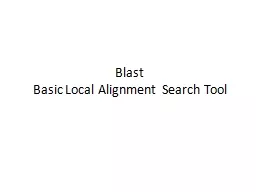PPT-From Smith-Waterman to BLAST
Author : myesha-ticknor | Published Date : 2016-08-10
Jeremy Buhler in absentia Wilson Leung 072015 Key limitations of the Smith Waterman local alignment algorithm Quadratic in time and space complexity Report
Presentation Embed Code
Download Presentation
Download Presentation The PPT/PDF document "From Smith-Waterman to BLAST" is the property of its rightful owner. Permission is granted to download and print the materials on this website for personal, non-commercial use only, and to display it on your personal computer provided you do not modify the materials and that you retain all copyright notices contained in the materials. By downloading content from our website, you accept the terms of this agreement.
From Smith-Waterman to BLAST: Transcript
Download Rules Of Document
"From Smith-Waterman to BLAST"The content belongs to its owner. You may download and print it for personal use, without modification, and keep all copyright notices. By downloading, you agree to these terms.
Related Documents














